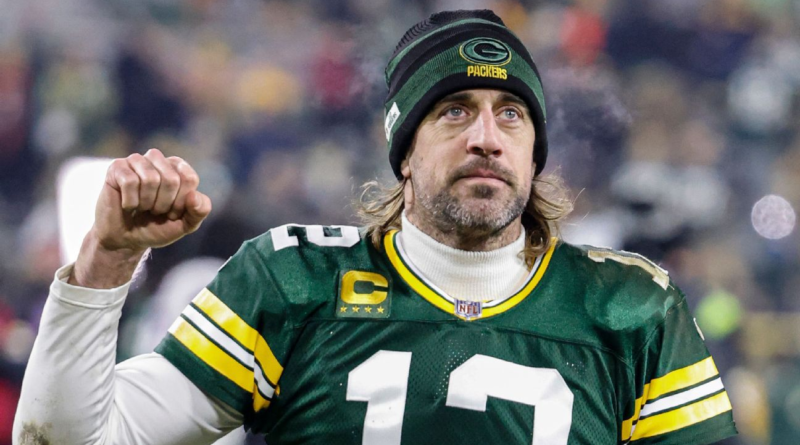Why the Aaron Rodgers trade won't be easy for Jets, Packers
FLORHAM PARK, N.J. — Aaron Rodgers wants to leave the Green Bay Packers and play for the New York Jets. The Jets want that, too. The Packers are willing to make a trade happen.
So what’s the holdup?
It’s a complex transaction, perhaps unprecedented. You’re talking about an all-time great quarterback with a massive contract. Those factors alone would make it difficult. That he’s 39 years old and already on record as saying he strongly considered retirement last month makes it harder to determine a fair price. He could walk away in a year. That’s why the Jets don’t want to part with their 2023 first-round draft pick (13th overall). At the same time, the Packers don’t want to trade a franchise icon for second- and third-day draft picks.
Leverage is in the eye of the beholder. The Jets are seemingly boxed into Rodgers because they don’t see a viable option on their roster and the quarterback market is depleted. (Baltimore Ravens star Lamar Jackson is available but carries the nonexclusive franchise tag.)
The Packers are boxed in because they appear committed to fourth-year quarterback Jordan Love and would like to move on from Rodgers. President Mark Murphy revealed the team’s hand recently, speaking of Rodgers in the past tense: “He had a great career here.”
One AFC executive called it “a unique situation,” saying he would expect the two sides to find common ground before ultimatums are issued.
Let’s examine the key questions surrounding the Jets-Rodgers-Packers saga:
Is there a sense of urgency for all parties to make a deal?
Not really. There are no financial deadlines on the near horizon, and the Jets don’t begin their offseason program until April 17. Actual practices don’t start until late May. The mandatory minicamp is in mid-June.
“It’s in everyone’s best interest to get it done sooner than later,” said former NFL executive Mike Tannenbaum, now an ESPN front-office analyst. “Typically, you need a deadline. Maybe the offseason program is the first deadline.”
Ideally, the Jets would love to have Rodgers in the building next month to get comfortable, to start the process of building chemistry with new teammates and to help with the installation of a new offense. At the same time, it’s not doomsday if he’s not there for the voluntary workouts. After all, he already has a feel for the offense, having played under offensive coordinator Nathaniel Hackett with the Packers.
There’s no guarantee he’d attend anyway. Rodgers, who has skipped the voluntary portion of the offseason in recent years, was noncommittal on whether he’d participate with the Jets, telling “The Pat McAfee Show” on Wednesday that “it’s one step at a time. I’m still in a contract [with the Packers].”
For the Jets, the benefit to getting a deal done sooner than later is peace of mind, just knowing their QB1 is locked up. No stress, no headache.
So when is the first real pressure point?
It’s April 27 — the first night of the draft. If it gets to this point, the Jets will have leverage because the Packers figure to want draft-pick compensation that will help them in 2023. If the Packers have to wait until 2024 to start reaping the benefits of a trade, it could be a diminished return, assuming the Jets improve their record and have a lower draft pick than 13th in 2024.
From a public relations standpoint, it probably wouldn’t be a great look for the Packers. Essentially, they’d be letting one of the most iconic players in franchise history twist in the wind while they pass up immediate draft capital.
In the midst of all this, they have to make a decision by May 1 on Love’s fifth-year option (2024), which is $20.3 million, fully guaranteed. This is a sneaky-important deadline. If they commit to Love for 2024, the Packers could try to float the idea that it allows them to keep Rodgers for another year and go to Love in ’24. That would be a tough sell, considering their glowing comments about Love and Rodgers’ unwillingness to return. He made it clear in the McAfee interview that he’s done with Green Bay.
Aren’t the Packers getting crushed on the cap by waiting?
Not at all. Truth be told, there’s a financial benefit to waiting.
Right now, Rodgers counts $31.6 million on the salary cap. If the Packers trade him before June 1, his cap charge balloons to $40.3 million — and they would have to carry that for the entire season. If they wait until after June 1 to deal him, the cap hit is spread out over two seasons — $15.8 million this year and $24.5 million in 2024. That would give them about $25 million in extra 2023 cap room to improve other areas of the roster.
In other words, if this stare-down drags past the draft, the Packers will have no motivation to make a trade before June 1. And if they wait that long, what’s to stop them from delaying until the start of training camp in late July? It would be a blow to the Jets if they open camp without their presumptive QB1.
When is the hard, gotta-have-it-done-by-then deadline for a trade?
The first game of the regular season (Sept. 10).
Under his existing contract, Rodgers has a $58.3 million option bonus (fully guaranteed) that must be exercised before the opening game. (The actual money gets doled out in two installments, the latter due by Sept. 30.) It’s hard to imagine the Packers paying that much money to a player they don’t want on the roster. If they don’t pay, the cap hit would be astronomical.
Could they swallow hard, welcome him back and pay the money? Technically, yes, but it’s difficult to foresee that happening.
The chances of the standoff reaching this point are highly unlikely. If it does, the Packers will be in dangerous territory with no leverage. And, of course, Rodgers’ value to the Jets would be diminished because he’d be showing up with no training camp. This scenario wouldn’t make sense for anyone.
What is reasonable compensation for Rodgers?
Everybody seems to have an opinion.
If the Jets remain steadfast in retaining their 2023 first-round pick, the two teams will need to get creative to make it work. It could take a firm pick (or picks) in 2023, plus a conditional pick (or picks) in 2024 or 2025. Those conditions could be based on individual and team performance and whether Rodgers returns for the 2024 season.
In 2008, the Packers traded Brett Favre to the Jets for a 2009 conditional fourth-round pick that improved to a third-round choice based on playing time. If the Jets had made the playoffs, it would’ve gone to a second-rounder. If they had reached the Super Bowl, it would’ve been a first-rounder. They might be willing to do something similar for Rodgers.
Tannenbaum, who negotiated the Favre deal for the Jets, said fair compensation for Rodgers would be a 2023 second-round pick and a 2024 conditional second- or third-round choice.
There’s always a chance that players could be involved. The Packers could use a wide receiver after losing Allen Lazard to the Jets. The Packers’ Matt LaFleur coached receiver Corey Davis when they were together with the Tennessee Titans. Davis could be deemed expendable with Lazard’s arrival.
There’s also the thought that the Packers, in lieu of a first-round pick, could ask for a player who was once graded highly on their draft board. The Jets have several players who might appeal to them. With a surplus of defensive ends, perhaps Jermaine Johnson — a late first-round pick in 2022 — would do the trick.
A key component in the discussions is the remaining money on Rodgers’ contract. Overall, he’s due $59.5 million in guarantees for 2023, and the Jets almost certainly want the Packers to pay a chunk of that. The more the Packers agree to pay, the more compensation they will receive in the form of draft picks and, possibly, players.
“I still have that fire and I want to play, and I would like to play in New York,” Rodgers said Wednesday. “It’s just a matter of, you know, getting that done at this point.”
ESPN Packers reporter Rob Demovsky contributed to this report.



